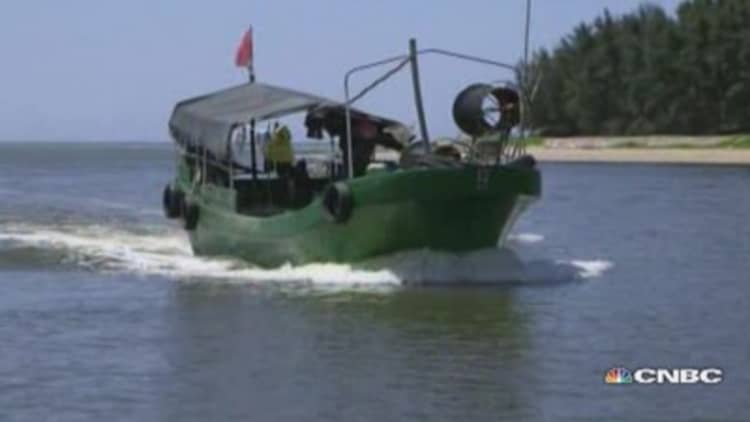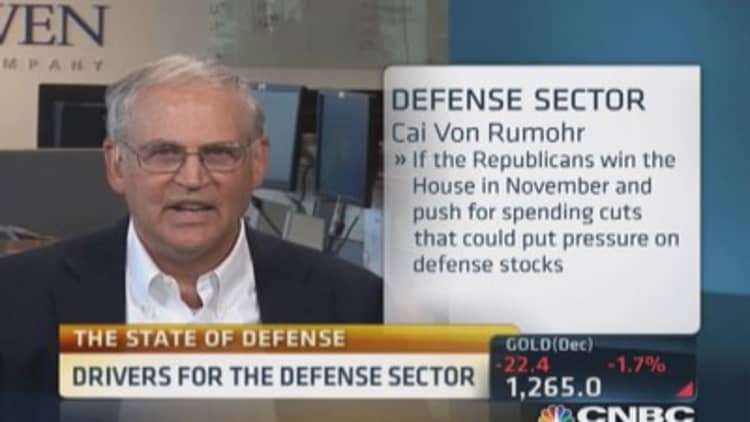Where American soldiers once fought a seemingly intractable guerrilla war, American-made weapons may find a new home.
The U.S. State Department said late Thursday that the United States is partially lifting a ban on "lethal aid" to its old enemy Vietnam, meaning that U.S. defense firms will be able to sell maritime defense systems to Vietnam for the first time since the end of the war in 1975.
And while American companies stand to gain from such a development, Southeast Asia is a highly competitive market where advanced U.S. technology can't necessarily count on beating out the competition.
Southeast Asia has flourished into a "buyer's market for defense equipment," said Jon Grevatt, Asia-Pacific industry reporter for IHS Jane's.
Countries including Vietnam, Malaysia and Indonesia are the ideal buyers for the global defense industry: They have the money, they have the capabilities to used advanced equipment and they are facing strategic pressures that compel purchases, Grevatt explained. Recognizing this, defense contractors in roughly 25 separate countries are competing to sell their wares in the region.
Vietnam Foreign Minister and Deputy Prime Minister Pham Binh Minh told Reuters two weeks ago that his country would welcome a chance to buy U.S. arms and "set up a comprehensive partnership with the United States."
Read More Chinese naval push could affect global trade
Russia currently dominates sales in the region, with Jane's estimating that it has accounted for about 40 percent of the market in recent years, followed by the United States with 20 percent. The rest of the sales are split between several European countries, South Korea and China.
Russia's hold on the market is quickly slipping, however. Countries are looking to diversify their defense suppliers because they "don't want to be dependent on one seller" and because they want to be able to shop around for the best price, Grevatt said. Additionally, he explained, Russia has not been as willing to share its technological know-how as suppliers from Europe or South Korea.

Geopolitics are also at play in the region's defense market. As smaller countries look to bolster their capabilities against increasingly expansionist China in places like the South China Sea, regional military buying is closely scrutinized by Beijing.
In fact, part of the reason that these nations are looking to new suppliers is that Russia—which has traditionally provided to Vietnam, Indonesia, Malaysia and Myanmar—is unwilling to sell some products that China has asked it to exclude, said Steve Zaloga, a senior analyst with aerospace and defense consulting firm Teal Group.
Read More Southeast Asia builds home-grown defense industry
"The Russians have tended to be rather dependent on China as an export client," Zaloga said, "So Russia is sort of in a bind when trying to sell to the Vietnamese."
What Vietnam-U.S. arms trade would look like
America's lifted embargo against Vietnam does not mean that it will immediately begin selling it advanced weaponry.
"The first step would be maritime systems, not offensive systems," Grevatt explained. "We won't see (fighter aircraft like) F-16s—that'll probably never happen."
The State Department told Reuters on Thursday that individual sales will be decided on a case-by-case basis.

While Washington may be hesitant to provide offensive weapons to Vietnam, it has other systems that would be highly prized in the country. Grevatt said that Vietnam has already expressed an interest in Lockheed's P-3 Orion maritime surveillance aircraft (which would not carry weapons) and Raytheon radar systems.
Vietnam would want to buy products like these because they are "arguably the best in the world," despite the fact that America would only be selling older models and would be unlikely to share technological know-how—unlike European competitors.
Read MoreThe Battle of 2014: A shrinking defense industry
But U.S. firms bring more to the table than just well-made, "refurbished" defense products, Grevatt said, because an arms deal with America amounts to a "strategic partnership" that carries some geopolitical weight. For countries like Vietnam, this sort of partnership is "important at a moment when the South China Sea is getting a bit testy," he said.
And tensions in the region are causing Vietnam to boost its military expenditures: IHS Jane's forecasts that the country's total defense budget will rise from $4.5 billion in 2014 to $5.6 billion in 2018 (these figures are higher than official figures to reflect actual spending).
But even with those increases, Vietnam is hard pressed to afford many American defense products. One mechanism by which the country may get the money is through U.S.-provided foreign military financing. The amount of money available there is "still not a lot," but it could ultimately provide an avenue to promote Vietnamese purchases, Grevatt said.
Read More What is China's end-game in South China Sea?
As far as Vietnam is concerned, one of the biggest problems with buying American defense products would be integrating them with the Russian-made systems it already has, Zaloga said. The problem won't ultimately prohibit purchases, but it could potentially influence some decisions.
The State Department told Reuters on Thursday that its agreement to lift the ban is "not an anti-China move."


